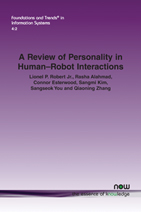A Review of Personality in Human–Robot Interactions
By Lionel P. Robert Jr., School of Information, Robotics Institute, University of Michigan, USA, lprobert@umich.edu | Rasha Alahmad, School of Information, University of Michigan, USA, rashama@umich.edu | Connor Esterwood, School of Information, University of Michigan, USA, cte@umich.edu | Sangmi Kim, School of Information, University of Michigan, USA, sangmik@umich.edu | Sangseok You, HEC Paris, Jouy-en-Josas, France, you@hec.fr | Qiaoning Zhang, School of Information, University of Michigan, USA, qiaoning@umich.edu
Abstract
Personality has been identified as a vital factor in understanding the quality of human–robot interactions. Despite this the research in this area remains fragmented and lacks a coherent framework. This makes it difficult to understand what we know and identify what we do not. As a result, our knowledge of personality in human–robot interactions has not kept pace with the deployment of robots in organizations or in our broader society. To address this shortcoming, this paper reviews 83 articles and 84 separate studies to assess the current state of human–robot personality research. This review: (1) highlights major thematic research areas, (2) identifies gaps in the literature, (3) derives and presents major conclusions from the literature and (4) offers guidance for future research.
A Review of Personality in Human–Robot Interactions
A Review of Personality in Human-Robot Interactions reviews the literature on personality and embodied physical action (EPA) robots. This monograph investigates the current state of human-robot personality research, discusses the unique role of personality in human-robot research, and offers guidance for future research.
A Review of Personality in Human-Robot Interactions offers several contributions to the literature. First, it presents a conceptual integrated model of the literature on personality in human-robot literature. Second, it highlights four thrust areas in the literature. These areas include: (1) Human Personality and HRI, (2) Robot Personality and HRI, (3) Robot Personality and HRI, and (4) Factors Impacting Robot Personality. Third, it derives and presents major insights from the literature. Finally, it identifies gaps in the literature that need to be addressed.
After the introduction, Section 2 presents the relevant literature including the inclusion and exclusion criteria for articles. Section 3 presents and discusses Thrust Area 1: Human Personality and HRI. In sections 4, 5, and 6, a similar discussion takes place for Thrust Area 2: Robot Personality and HRI, Thrust Area 3: Robot Personality and HRI, and Thrust Area 4: Factors Impacting Robot Personality, respectively. Section 7 follows with a discussion on the way forward, focusing on the opportunities for personality research in human‒robot interaction.
